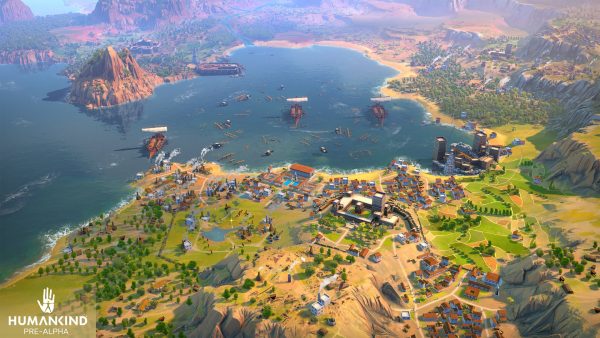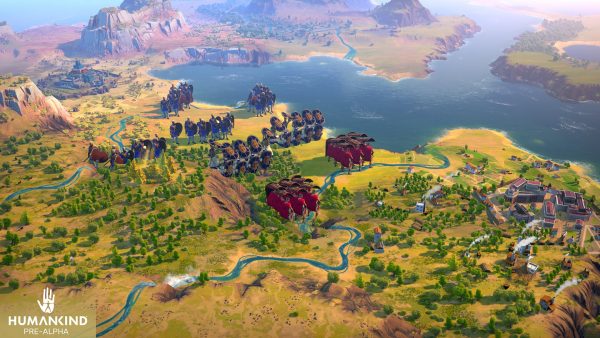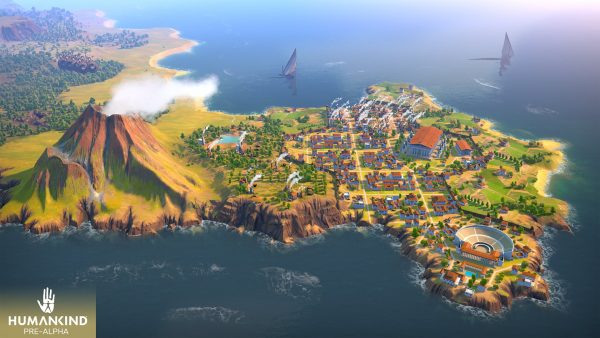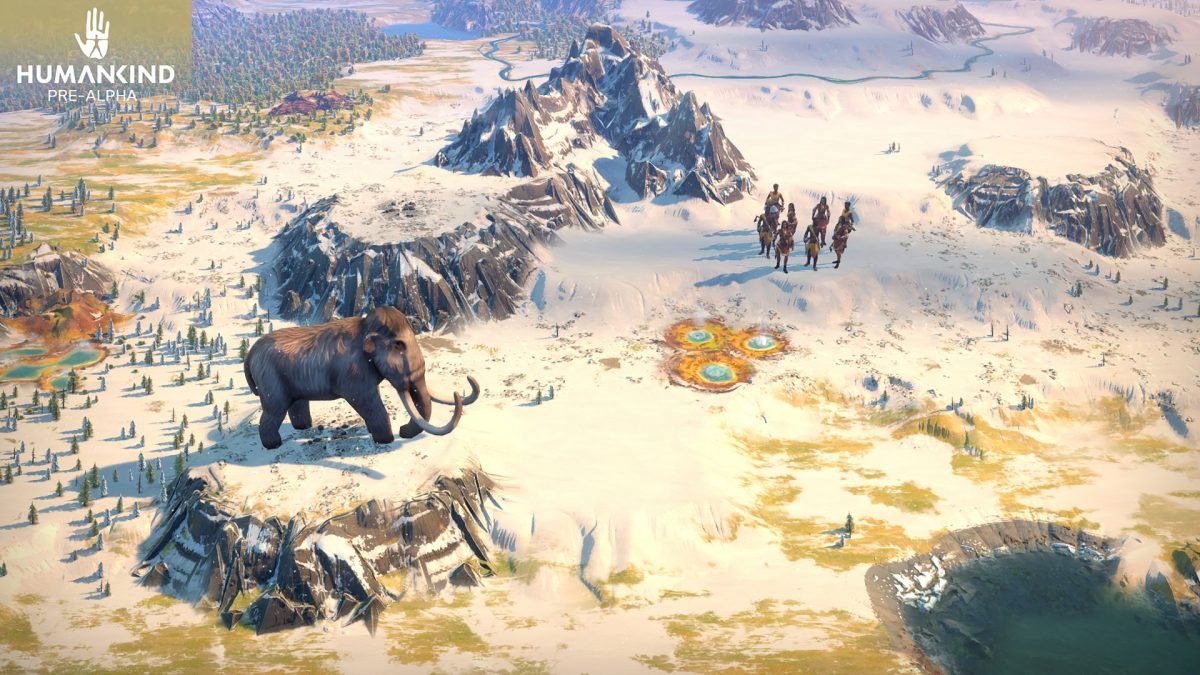4X strategy games gained prominence through the Civilization series, and for good reason. After all, building your nation from the ground up until they manage to reach the space age tends to be a huge draw for fans. However, the games are now getting a bit stale, and sometimes we just need something a bit more. That’s where Humankind comes in. Check out our preview below of the Humankind game and see how it stacks up against more established franchises.
What Is Humankind?


The game Humankind is an upcoming 4X strategy title set to be released by SEGA and created by Amplitude Studios. The game was slated to be released on April 22 this year for PC, Stadia, and MacOS. However, they delayed the release date for August 17 to polish up the game a bit more.
What Kind of Game Is It?
If you haven’t guessed it already, this title is 4X grand strategy game. As for what 4X stands for, well, it’s an abbreviation of four words: explore, expand, exploit, and lastly, exterminate. They’re a subgenre to strategy games available on both PC and board games and can encompass both RTS and turn-based gameplay. The gameplay is focused on the creation of an empire, with emphasis placed on technological and economic development. There’s also a wide range of military and non-military avenues of nations gaining supremacy.
The earliest 4X games that came out during the time took ideas from various board games, as well as text-based PC games back in the 1970s. The first 4X games at the time were turn-based. However, there are some real-time 4X games in the market as well. A lot of 4X PC games were released back in the mid-1990s. However, they were later outsold by other subgenres of strategy games out at the time. At that point, Sid Meier’s Civilization is the 4X game that popularized the amount of minutia and detail that would become the staple of the genre.
Humankind Game Preview
Gameplay


The Humankind game is currently being compared to the Civilization series. In the various demos that were released, players will lead their various civilizations through six major eras that Humankind went through. They start in the nomadic age, where they proceed to hunt for food and claim the land as their own. Then they move to more advanced civilizations like the Egyptians and the Hittites.
The players are the ones that dictate how their civilization should expand, choosing what civilization to adapt to different eras once they pass the nomadic age. After that point, the usual 4X gameplay begins. They start to create cities, make and control military and other units while interacting with other civilizations they encounter on the virtual planet. Said planet is randomly generated when starting a new game.
As stated above, one of the distinguishing features is the ability to choose civilizations at will based on actual historical civilizations. This selection of nations and peoples offers bonuses and penalties that are specific to said civilization that can make or break a player’s run. Because of this, players can choose different civilizations to build upon their own, with potentially a million unique civilization patterns that players can create their custom civilization from.
Making Your Cities
Creating cities in Humankind is similar to Amplitude’s previous game, Endless Legend. Any continent in the game will have multiple territories inside of it. Players will then be able to build only one city in said territory that they can then expand upon. These expansions can be farms, artisan areas, mines, and the exploitation of other outlying resources. In addition to this, if players create outposts on adjacent territories, they can combine them to the city. This, plus the expansions, gives players the ability to create large metropolises that can span multiple territories if they wish.
War and Combat
In the game Humankind, players aren’t just the decision-making figurehead that their empire will have. Similar to Civilization, players can also command, and hand out orders while a battle is joined. This, of course, means that players need to be wary, and have to efficiently use their units and even the terrain if they want to win. When not in battle, the player’s units can be grouped into armies, which allow players to command and control a lot of units efficiently. When a battle is joined, units that are on the same group will immediately deploy and act individually on a limited battlefield that’s still played on the main map.
All of the armies that the players bring inside this projected battlefield space will duke it out for ultimate supremacy. This means that if the players think that things are a bit bleak, they’ll have the ability to bring reinforcements to boost their chances. There’s even the ability to bring in armies into battles that are active so that you can use them as reinforcements, or even, to outflank the enemy.
Every unit available on Humankind has a class and a single ability that has a role in the game’s combat. These effects can range from combat strength to some pretty niche effects. We don’t know a lot about those yet, but we’ll probably see more when the game releases. In addition to this though, the game does have auto battling for those that just want to get the battles over with. But we recommend doing this only on battles where you’re certain to win.
Battles and Positioning
As stated, battles will be fought directly on the game’s world map, which is novel compared to other 4X strategy games that play battles on a separate war-specific one. Though they’re not the only ones that do such a thing, Stellaris for example plays the battles in real time in space. However, due to the turn-based nature of Humankind’s combat, the simple details of the game’s battles matter.
Players, of course, have complete control over where their units are put on the game’s battlefield. After the positioning, they will then have to decide where units go, as well as who or what they fight. Also, players can take advantage of the battlefield’s terrain. The developers stated that battlefield manipulation in Humankind is key, with them stating that it’s one of the pillars of Humankind’s gameplay.
With a good head and a keen eye, players can use the map’s terrain to obtain various advantages when in battle. For example, you can put archers on cliffs to rain down arrows on enemies below while protecting them from retribution. You can also hide a group of units in forested areas to gain the element of surprise. Some units work best on specific unit tiles, which we’ll see more later when the game is fully released.
Graphics


Graphics-wise, the game looks like a more polished Civilization 6, but not by much. The game has some additional flourishes here and there that make it different from the Civilization series. However, the overall atmosphere of the game is highlighted by bright tones and really good character models. It helps that the models change over time depending on the current era and type of civilization. But those additional stylistic additions are things that you can see for yourself when you play the game on launch.
Sound and OST
In terms of Humankind’s OST, there’s a bit of similarity in the OST that Humankind currently has to the Civilization series. However, it’s more of a distant kind of similarity, perhaps in the instruments that the OST is using. Don’t let that take away from the fact that the OST and sound design of the game help in showing the Grand Strategy of Humankind.
Humankind Game vs Other 4X RTS Titles
Now that we’ve talked about Humankind the game and its features, we need to talk about how it compares to other 4X games below.
Sid Meier’s Civilization Series
The granddaddy of all 4X games and the series that catapulted the genre into the main stage. Sid Meier was an absolute visionary when he made the Civilization series, and throughout the years, the game has evolved. He added in new nations, patched a few of the more overpowered ones (except India and Gandhi), and has come a long way overall. The current iteration of the series, Civilization VI, is still played to this day even after five years have passed. It just goes to show how influential the series is.
Although, the main reason as to why that’s the case is due to the various DLCs that the game’s developers dish out. Now don’t get us wrong; that’s typical for all the 4K strategy games that are on this list. Do note, however, that most of these DLCs are Scenario Packs and new playable nations. However, there are some DLCs in the game that add in new balance changes on the gameplay and other new stuff. These range from extra scenarios to even full-on patches for the game. All in all, the game is alive and well. Combine that with some mods (though not as much as Stellaris, which we’ll talk about below), and you’re golden.
All in all, don’t count out the Civilization Series yet. The game still has a lot of life in it and players are still playing the game as well as its expansions. Who knows, maybe we’ll get a Civilization 7 later on in the years as time goes by, but that’s just wishful thinking.
Stellaris
Now Stellaris is a game that has you sail the Sea of Stars, to explore what’s out there and to go even further beyond. You control a new galactic nation that discovered faster-than-light travel just recently. And thus, it’s your job as the player to ensure that they explore the stars and conquer the systems on their own.
After you manage to get a nice part of space for your own, you then meet your galactic neighbors. It’s up to you at this point to figure out what to do. You can either befriend them, insult them, and wage war with them. Do note though, that doing too many bad things might lead to some consequences later on in terms of relationships with other Empires. However, what are a few cracked eggs for the glory of the Imperium of Man.
Other than the usual shenanigans of 4X games out there, Stellaris can dazzle you with the sheer amount of stuff you can do. The game is also one of the best 4X games in the market that allows players to mod it however they like. Want bigger and better Megastructures? You can get those with mods. Want new race portraits for your species? You can get those. What about new Civics, Traits, and even full stop ships and gameplay changes? Well, the modding community of Stellaris has you covered.
In terms of DLC, the game has a lot of good ones that not only add in new species but change how the game is played fundamentally. The most recent of these new DLCs would be the Nemesis DLC, which is going to come alongside a free patch on April 15.
Europa Universalis IV
Yet another one of Paradox Interactive’s games, Europa Universalis IV is one of the more accurate renditions of the lives and times of Europe way back in the day. You play as an individual from one of the ruling monarchies and nations in Europe and the rest of the world and then try to expand your influence. Overall, the game is an incredibly deep 4X strategy game, but that’s pretty typical for the genre, so what makes it different?
Well, for one, you start at a predetermined point in time of our world’s history, 1444 AD specifically, and the game ends in 1821 AD. Your goal for the entire game is simple, you build a nation, or take an existing nation and ensure that by the end of the game, your nation is the best off at that point. Simple when stated right? Well, it’s a bit hard on execution due to some additional conundrums.
For one, you’re starting on 1444 AD, the late end of the Late Medieval Period which started from 1250 AD and ended in 1500 AD. Thus, there are already pre-determined land borders for each of the nations in question. Second, the nations don’t start equally. An example would be the fact that Mazovia is one of the smaller nations then. With luck and some good management, you can expand your nation and become a world power. You just need to maneuver yourself properly.
The thing is, the game is one of the more complicated 4X strategy games out there. Don’t let that stop you, though; the depth of gameplay can lead to some really interesting scenarios and events.
Warhammer 40K: Gladius – Relics of War
Next up would be Warhammer 40K: Gladius – Relics of War, and for 40K fans, this should be a breath of fresh air. After all, they haven’t had a good run in terms of games and other media in general. Dawn of War 3, for example, was a total mess and didn’t pan out the way people wanted it to be. Movies? They’re non-existent, but at least the books are there though. But with Gladius, the gaming part of the community got a new life.
Your job is to conquer the planet of Gladius Prime after it got hit by Warp Storm. To do this, you can choose between four factions on the base game, an additional four thanks to DLC. These factions are the Astra Militarum, the Space Marines, Orks, and capping up the main factions, the Necrons. The fou DLC factions are the Tyranids, Chaos Space Marines, The T’au, and lastly, the Craftworld Aeldari.
Either way, you’re going to have to fight the rest of these factions to claim supremacy over Gladius Prime. Luckily, or unluckily for you, there are some good things hidden in this planet for you to… appropriate. You only need to find them first before your enemies do. Other than that, the game is pretty similar to other 4X strategy games. However, it has an extra emphasis on combat, which is understandable, given that it’s 40K.
Should RTS Fans Be Excited for Humankind?
If you’re a fan of the Civilization series but felt like it’s getting stale, then it might be a good idea to pick up Humankind the game. The game is shaping up to be an incredibly fun, yet complex 4X strategy game for the ages, and we can’t wait to see where it goes.
For now, we can only wait.

























